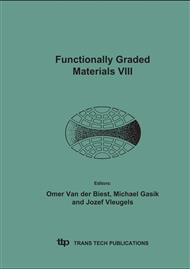[1]
ISO Guide 30: Terms and definitions used in connection with reference materials. (International Organization for Standardization, Switzerland 1992).
Google Scholar
[2]
P. Howarth and F. Redgrave: Metrology - in short (ISBN 87-988154-1-2, 2nd ed. 2003. ).
Google Scholar
[3]
ISO Guide 31: Reference materials - Contents of certificates and labels. (International Organization for Standardization, Switzerland 2000).
Google Scholar
[4]
L. Kempenaers, K. Janssens, L. Vincze, B. Vekemans, A. Somogyi, M. Drakopoulos, A. Simionovici, F. Adams: Anal. Chem. Vol. 74 (2002), p.5017.
DOI: 10.1021/ac025662g
Google Scholar
[5]
L. Kempenaers, K. Janssens, K. P. Jochum, L. Vincze, B. Vekemans, A. Somogyi, M. Drakopoulos, F. Adams: J. Anal. At. Spectrom. Vol. 18 (2003), p.350.
DOI: 10.1039/b212196d
Google Scholar
[6]
Certificate of Analysis, Standard Reference Material 613, Trace elements in a glass matrix. (National Institute of Standards and Technology, USA 1992).
Google Scholar
[7]
Certificate of Analysis, Standard Reference Material 482, Gold-copper wires for Microprobe analysis. (National Institute for Standards and Technology, USA 1988).
Google Scholar
[8]
Certificate of Analysis, Standard Reference Material 2063a, Microanalysis thin film Mg-SiCa-Fe. (National Institute for Standards and Technology, USA 1993).
Google Scholar
[9]
Certificate of Analysis, Standard Reference Material 2066, K-411 Glass Microspheres. (National Institute for Standards and Technology, USA 2000).
Google Scholar
[10]
R. Jacobs, J. Meneve, G. Dyson, D. G. Teer, N. Jennett, P. Harris, J. von Stebut, C. Comte, P. Feuchter, A. Cavaleiro, H. Ronkainen, K. Holmberg, U. Beck, G. Reiners, C. D. Ingelbrecht: Surf. & Coat. Tech. Vol. 174-175 (2003), p.1008.
DOI: 10.1016/s0257-8972(03)00470-5
Google Scholar
[11]
C. D. Ingelbrecht, R. Jacobs, J. Meneve, N. Jennett: The certification of critical coating failure loads a reference material for scratch testing according to ENV 1071: 1994, BCR- 692 (Office for Official Publications of the European Communities, Luxembourg).
Google Scholar
[12]
G. Aldrich-Smith, N. Jennett, J. Housden: A round robin to measure the adhesion of thin coatings (VAMAS Technical Working Area 22, Report No. 46, ISSN 1016-2186, 2004).
Google Scholar
[13]
K. Herrmann, N. M. Jennett, W. Wegener, J. Meneve, K. Hasche, R. Seemann: Thin Solid Films Vol. 377-378 (2000), p.394.
DOI: 10.1016/s0040-6090(00)01367-5
Google Scholar
[14]
H. Maes: The certification of the thickness of thin SiO2 layers on silicon wafers as measured by spectroscopic ellipsometry (IMEC, Belgium 1995).
Google Scholar
[15]
J. Nunn, W. Mirande, N. Talene, P. Salieri: The BCR sub-micrometre photomask linewidth standard BCR-676 (Office for Official Publications of the European Communities, Luxembourg 1998).
Google Scholar


